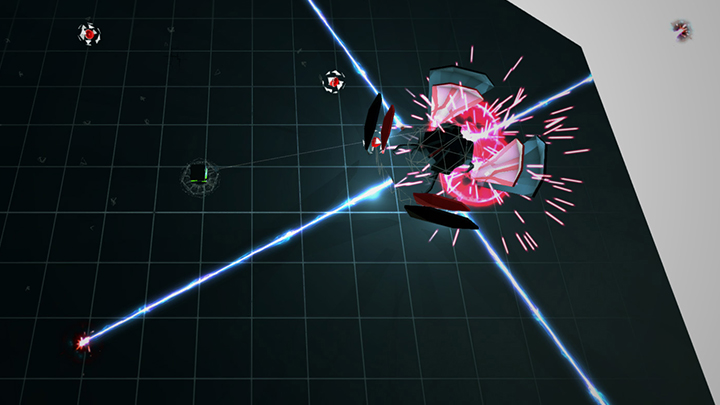What if hacking resembled a game? Enemies to kill, bosses to topple and levels to complete, realism be damned? ATOMINE offers an answer, and now it’s available for Switch owners to try out.
ATOMINE is a top down rougelite twin-stick shooter. When you boot up the game initially, there’s only a choice of one playable ATOMINE variant, with more unlocked based upon progression. When you enter the game proper, it’s quickly noticeable that there’s no tutorial, and you’re thrown straight into the gameplay.
There’s no story mode to speak of, but there is some given backstory for what’s going on. In 2011, the existence of a highly dangerous computer virus called STUXNET was made known after it was discovered by some programmer. STUXNET is malicious spyware that spies on and attacks industrial networks such as power grids and oil fields. The titular ATOMINE is an anti-virus created to destroy STUXNET, but it first needs to compile itself into the source code (clear levels) and grow in strength (getting upgrades) to do so… and that’s where any semblance of a story ends. There’s no high stakes plot being set up, and really, as the game is presented, there was no need for it.
This follows into how the game works. In true minimalist fashion and as advertised, you use the analog sticks to move and shoot (so no single Joy-Con play). Left stick moves around, right stick not only aims, but shoots while aiming as well. At first, it felt a bit awkward, having played twinstick shooters which incorporate most of the buttons available, but after a while it grows on you, especially with how fast paced the action gets.
In every level, the aim is to destroy a certain amount of enemies before advancing to the next area. Enemies might look same-y given the presentation, but there are differences in behavior, speed and durability for each of them. Some are stationary, others chase you down, while some others might have a combination of aspects, such as being stationary but dropping an explosive upon being killed to punish any player not paying attention. They do keep you on your toes, especially with the procedurally generated level design.
An aspect also present in most levels are upgrade stations. You have to find them hidden away, marked by a blue dot on the minimap, and from there you can choose a singular upgrade such as more health or double experience, followed by customization of your weapon, modifying aspects like the projectile type, (with bullets or lasers as examples) as well as the fire rate, range and spread. Note, however, that these upgrades are obtained as random drops from enemies, so each playthrough will be different in terms of how you upgrade the ATOMINE, complementing the overall randomized aspects of level design and enemies.
This random design lends itself to issues that can come across as questionable and create a sense that the game is harder than it was should have been. It’s entirely possible that you’re generated into a room with too many enemies at once, tearing through your health. Sometimes a level is finnicky on which enemies need to be killed for the next area to open, as some enemies respawn whilst others don’t. The bosses in between some levels can be either cakewalks or wars of attrition depending on your upgrades. Worst of all, death is final; if you lose all your energy, it’s right back to the beginning, albeit with any special unlocks like other ATOMINE types retained. These are issues which can make the game frustrating at times, so enjoyment, ironically true to the spirit of the game, can feel random.
ATOMINE, owing to its cyberspace setting, has a unique look. It’s not a bright paradise like the Grid in Tron is, but it’s clear the developers wanted to deliver their own interpretation of cyberspace, and it’s nice. There are even glitch effects for when you’re hit (sometimes) or when STUXNET tries to eliminate you and a QTE is necessary for preventing that, so the tech feel is authentic. If the glitch effects annoy you, though, there’s an option to turn them off, a nice touch. The music, while it doesn’t fit the cyberspace aesthetic quite as well as the graphics, isn’t boring to listen to even when there’s only a couple of tracks. The sound balancing seems to be off, though, so make sure to lower the music volume via the settings. Otherwise, good presentation.
Ultimately, ATOMINE is a bit conflicting. The core mechanics work well, there are no performance issues coupled with a smooth, stable framerate that runs at 60 fps, and it has good presentation. But it’s the other side of the core mechanics, the randomization, which can drag the game down via sudden difficulty spikes. On the other hand, there’s a lot to unlock and experiment with, so you’re getting your money’s worth with ATOMINE. If you enjoy roguelites, then it’s for you, but if you’re not a fan of games employing procedural generation, then be wary.








